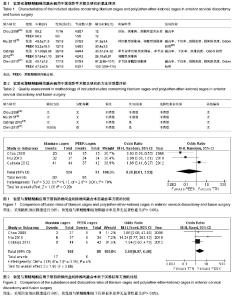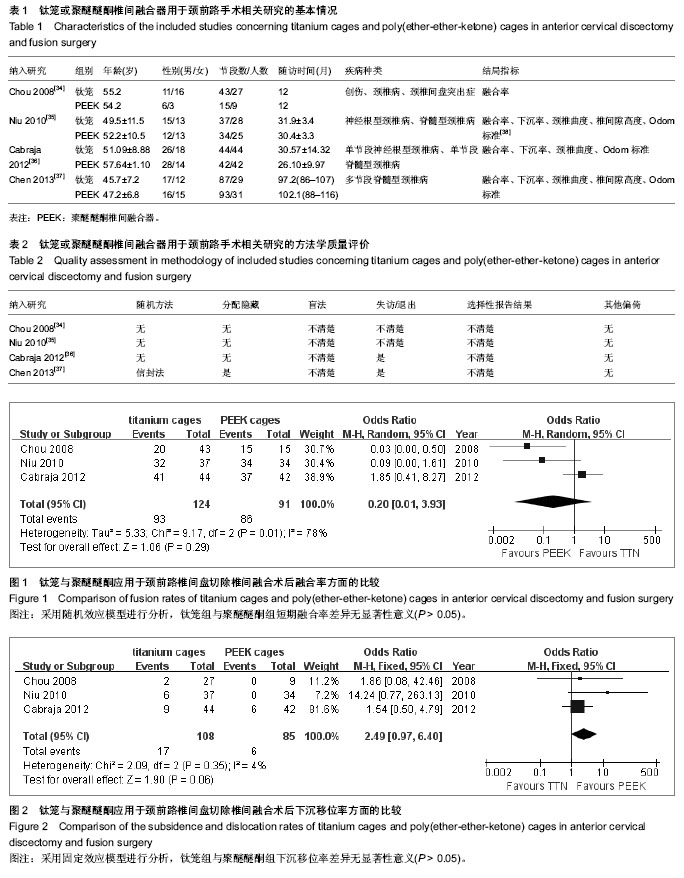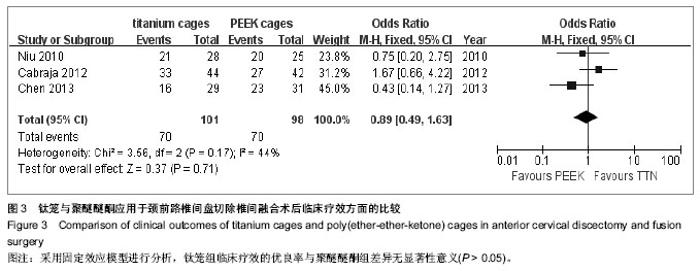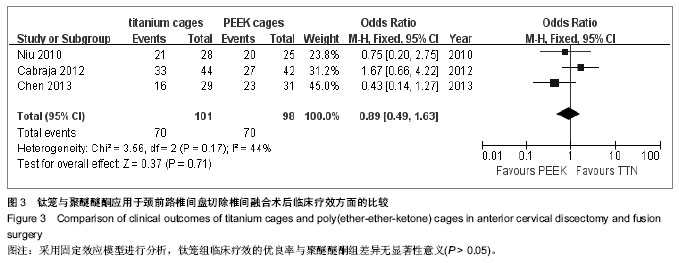Chinese Journal of Tissue Engineering Research ›› 2014, Vol. 18 ›› Issue (4): 625-630.doi: 10.3969/j.issn.2095-4344.2014.04.023
Previous Articles Next Articles
Application of titanium cages and poly(ether-ether-ketone) cages in anterior cervical discectomy and fusion surgery
Duan Wen1, Kong Rong1, Huang Wei1, Zhou Ran2
- 1First Department of Orthopedics, Anhui Provincial Hospital, Hefei 230001, Anhui Province, China; 2Anhui Provincial Center for Evidence-Based Medicine, Hefei 230001, Anhui Province, China
-
Revised:2013-10-21Online:2014-01-22Published:2014-01-22 -
About author:Duan Wen, Master, First Department of Orthopedics, Anhui Provincial Hospital, Hefei 230001, Anhui Province, China
CLC Number:
Cite this article
Duan Wen1, Kong Rong1, Huang Wei1, Zhou Ran2. Application of titanium cages and poly(ether-ether-ketone) cages in anterior cervical discectomy and fusion surgery[J]. Chinese Journal of Tissue Engineering Research, 2014, 18(4): 625-630.
share this article

2.1 检索结果分析 共检索出文献188篇,通过阅读文献标题及摘要,初步筛选出22篇文献可能符合纳入标准,再通过阅读全文后,最终纳入4篇研究[34-37],均为英文文献。 2.2 基线分析及质量评价 表1为纳入研究的基本情况。 通过“随机方法、分配隐藏、盲法、失访/推出、选择性报告结果、其他偏倚”6个方面对纳入研究进行系统评价(表2)。 2.3 系统评价结果 2.3.1 融合率 4项研究均报道了融合率,其中3项研究对短期融合率进行比较[34-36],1项研究为长期研究[37]。对3项短期研究进行Meta分析,其中钛笼组124个节段,聚醚醚酮组91个节段,对研究结果进行异质性分析,结果存在异质性(P=0.01, I2=78%),因此采用随机效应模型进行分析。结果显示钛笼组与聚醚醚酮组短期融合率差异无显著性意义(P > 0.05)(图1)。在这项长期研究中钛笼组与聚醚醚酮组均达到骨性融合。 2.3.2 颈椎曲度 由于纳入研究对颈椎前凸角度的指标不一,因此未进行Meta分析。Niu等[35]经过2年的随访认为术后对颈椎病变节段前凸的纠正角度钛笼组与聚醚醚酮组差异无显著性意义(P > 0.05),在随访结束时两组颈椎病变节段前凸角度的丢失程度差异同样无显著性意义(P > 0.05)。Cabraja等[36]的研究认为钛笼组与聚醚醚酮组术后较术前颈椎曲度均有明显恢复,但两组之间术后及2年随访结束时颈椎曲度差异均无显著性意义(P > 0.05)。Chen等[37]的研究认为两组术后颈椎曲度差异无显著性意义 (P > 0.05),7年随访后聚醚醚酮组颈椎曲度要优于钛笼组,差异有显著性意义(P < 0.05),在颈椎曲度丢失方面,聚醚醚酮组要小于钛笼组,差异有显著性意义(P < 0.05)。 2.3.3 融合节段椎间隙高度 由于纳入研究评价椎间隙高度的指标不一,因此未进行Meta分析。Niu等[35]的研究发现经过2年的随访,聚醚醚酮组术后椎间隙前缘及后缘高度的丢失要明显小于钛笼组,差异具有显著性意义(P < 0.05)。Chen等[37]的研究发现,经过7年的随访,聚醚醚酮组术后椎间隙高度的丢失要明显小于钛笼组,差异有显著性意义(P < 0.05)。 2.3.4 下沉移位率 4篇研究对椎间融合器下沉及移位均有描述,对3篇短期研究进行Meta分析[34-36],其中钛笼组108个节段,聚醚醚酮组85个节段,对研究结果进行异质性分析,结果不存在异质性(P=0.35,I2= 4%),因此采用固定效应模型进行分析。结果显示钛笼组与聚醚醚酮组下沉移位率差异无显著性意义(P > 0.05) (图2)。但是在这项长期研究中[11,37]结果显示聚醚醚酮组的下沉移位率要小于钛笼组,差异有显著性意义(P < 0.05)。 2.3.5 临床疗效 有3项研究采用Odom标准对临床疗效进行评价[35-37],其中2篇为短期[35-36],1篇为长期[37],但考虑临床疗效短期长期变化不大,因此纳入这3项研究进行Meta分析,其中钛笼组101例患者,聚醚醚酮组98例患者,对研究结果进行异质性分析,结果不存在异质性(P= 0.17,I2 = 44%),因此采用固定效应模型进行分析。结果显示钛笼组与聚醚醚酮组的临床疗效差异无显著性意义(P > 0.05) (图3)。 "

| [1] Cloward RB.The anterior approach for removal of ruptured cervical disks.J Neurosurg. 1958;15(6):602-617.[2] Smith GW, Robinson RA.The treatment of certain cervical-spine disorders by anterior removal of the intervertebral disc and interbody fusion.J Bone Joint Surg Am. 1958;40-A(3):607-624.[3] Zdeblick TA, Ducker TB.The use of freeze-dried allograft bone for anterior cervical fusions.Spine (Phila Pa 1976). 1991;16(7): 726-729.[4] Young WF, Rosenwasser RH. An early comparative analysis of the use of fibular allograft versus autologous iliac crest graft for interbody fusion after anterior cervical discectomy.Spine (Phila Pa 1976). 1993;18(9):1123-1124.[5] Baba H, Furusawa N, Tanaka Y,et al.Anterior decompression and fusion for cervical myeloradiculopathy secondary to ossification of the posterior ligament.Int Orthop. 1994;18(4): 204-209.[6] An HS, Simpson JM, Glover JM,et al.Comparison between allograft plus demineralized bone matrix versus autograft in anterior cervical fusion. A prospective multicenter study.Spine (Phila Pa 1976). 1995;20(20):2211-2216.[7] Malloy KM, Hilibrand AS.Autograft versus allograft in degenerative cervical disease.Clin Orthop Relat Res. 2002; (394):27-38.[8] Truumees E, Demetropoulos CK, Yang KH,et al. Effects of disc height and distractive forces on graft compression in an anterior cervical discectomy model.Spine (Phila Pa 1976). 2002;27(22):2441-2445.[9] Kaiser MG, Haid RW Jr, Subach BR,et al.Anterior cervical plating enhances arthrodesis after discectomy and fusion with cortical allograft.Neurosurgery. 2002;50(2):229-36.[10] Thomé C, Krauss JK, Zevgaridis D.A prospective clinical comparison of rectangular titanium cages and iliac crest autografts in anterior cervical discectomy and fusion. Neurosurg Rev. 2004;27(1):34-41. [11] Jagannathan J, Shaffrey CI, Oskouian RJ,et al.Radiographic and clinical outcomes following single-level anterior cervical discectomy and allograft fusion without plate placement or cervical collar.J Neurosurg Spine. 2008;8(5):420-428.[12] Francke EI, Demetropoulos CK, Agabegi SS,et al.Distractive force relative to initial graft compression in an in vivo anterior cervical discectomy and fusion model.Spine (Phila Pa 1976). 2010;35(5):526-530.[13] Younger EM, Chapman MW.Morbidity at bone graft donor sites.J Orthop Trauma. 1989;3(3):192-195.[14] Zdeblick TA, Phillips FM.Interbody cage devices.Spine (Phila Pa 1976). 2003;28(15 Suppl):S2-7.[15] Schmieder K, Wolzik-Grossmann M, Pechlivanis I,et al. Subsidence of the wing titanium cage after anterior cervical interbody fusion: 2-year follow-up study.J Neurosurg Spine. 2006;4(6):447-453.[16] Arrington ED, Smith WJ, Chambers HG,et al.Complications of iliac crest bone graft harvesting.Clin Orthop Relat Res. 1996; (329):300-309.[17] Goulet JA, Senunas LE, DeSilva GL,et al.Autogenous iliac crest bone graft. Complications and functional assessment.Clin Orthop Relat Res. 1997;(339):76-81.[18] Brooke NS, Rorke AW, King AT,et al.Preliminary experience of carbon fibre cage prostheses for treatment of cervical spine disorders.Br J Neurosurg. 1997;11(3):221-227.[19] Cho DY, Liau WR, Lee WY,et al.Preliminary experience using a polyetheretherketone (PEEK) cage in the treatment of cervical disc disease.Neurosurgery. 2002;51(6):1343-1349.[20] Wang X, Chen Y, Chen D,et al.Anterior decompression and interbody fusion with BAK/C for cervical disc degenerative disorders.J Spinal Disord Tech. 2009;22(4):240-245. [21] Moreland DB, Asch HL, Clabeaux DE,et al.Anterior cervical discectomy and fusion with implantable titanium cage: initial impressions, patient outcomes and comparison to fusion with allograft.Spine J. 2004;4(2):184-191.[22] Matgé G.Cervical cage fusion with 5 different implants: 250 cases.Acta Neurochir (Wien). 2002;144(6):539-549.[23] Hwang SL, Lin CL, Lieu AS,et al.Three-level and four-level anterior cervical discectomies and titanium cage-augmented fusion with and without plate fixation.J Neurosurg Spine. 2004;1(2):160-167.[24] van Jonbergen HP, Spruit M, Anderson PG,et al. Anterior cervical interbody fusion with a titanium box cage: early radiological assessment of fusion and subsidence.Spine J. 2005;5(6):645-649.[25] Kao FC, Niu CC, Chen LH,et al.Maintenance of interbody space in one- and two-level anterior cervical interbody fusion: comparison of the effectiveness of autograft, allograft, and cage.Clin Orthop Relat Res. 2005;(430):108-116.[26] Hwang SL, Hwang YF, Lieu AS,et al.Outcome analyses of interbody titanium cage fusion used in the anterior discectomy for cervical degenerative disc disease.J Spinal Disord Tech. 2005;18(4):326-331.[27] Katzer A, Marquardt H, Westendorf J,et al. Polyetheretherketone- cytotoxicity and mutagenicity in vitro.Biomaterials. 2002;23(8):1749-1759.[28] Toth JM, Wang M, Estes BT,et al.Polyetheretherketone as a biomaterial for spinal applications.Biomaterials. 2006;27(3): 324-334.[29] Boakye M, Mummaneni PV, Garrett M,et al.Anterior cervical discectomy and fusion involving a polyetheretherketone spacer and bone morphogenetic protein.J Neurosurg Spine. 2005;2(5):521-525.[30] Dorai Z, Morgan H, Coimbra C.Titanium cage reconstruction after cervical corpectomy.J Neurosurg. 2003;99(1 Suppl):3-7.[31] Cutler AR, Siddiqui S, Mohan AL,et al.Comparison of polyetheretherketone cages with femoral cortical bone allograft as a single-piece interbody spacer in transforaminal lumbar interbody fusion.J Neurosurg Spine. 2006;5(6): 534-539.[32] Chiang CJ, Kuo YJ, Chiang YF,et al.Anterior cervical fusion using a polyetheretherketone cage containing a bovine xenograftp: three to five-year follow-up.Spine (Phila Pa 1976). 2008;33(23):2524-2528. [33] Lemcke J, Al-Zain F, Meier U, et al. Polyetheretherketone (PEEK) Spacers for Anterior Cervical Fusion: A Retrospective Comparative Effectiveness Clinical Trial.Open Orthop J. 2011; 5:348-353.[34] Chou YC, Chen DC, Hsieh WA,et al.Efficacy of anterior cervical fusion: comparison of titanium cages, polyetheretherketone (PEEK) cages and autogenous bone grafts.J Clin Neurosci. 2008;15(11):1240-1245.[35] Niu CC, Liao JC, Chen WJ,et al.Outcomes of interbody fusion cages used in 1 and 2-levels anterior cervical discectomy and fusion: titanium cages versus polyetheretherketone (PEEK) cages.J Spinal Disord Tech. 2010;23(5):310-316.[36] Cabraja M, Oezdemir S, Koeppen D,et al.Anterior cervical discectomy and fusion: comparison of titanium and polyetheretherketone cages.BMC Musculoskelet Disord. 2012; 13:172. [37] Chen Y, Wang X, Lu X,et al.Comparison of titanium and polyetheretherketone (PEEK) cages in the surgical treatment of multilevel cervical spondylotic myelopathy: a prospective, randomized, control study with over 7-year follow-up.Eur Spine J. 2013;22(7):1539-1546. [38] Odom GL, Finney W, Woodhall B.Cervical disk lesions.J Am Med Assoc. 1958;166(1):23-28.[39] Barsa P, Suchomel P.Factors affecting sagittal malalignment due to cage subsidence in standalone cage assisted anterior cervical fusion.Eur Spine J. 2007;16(9):1395-1400.[40] Wilke HJ, Kettler A, Goetz C,et al.Subsidence resulting from simulated postoperative neck movements: an in vitro investigation with a new cervical fusion cage.Spine (Phila Pa 1976). 2000;25(21):2762-2770.[41] Gercek E, Arlet V, Delisle J,et al.Subsidence of stand-alone cervical cages in anterior interbody fusion: warning.Eur Spine J. 2003;12(5):513-516. [42] Hacker RJ.A randomized prospective study of an anterior cervical interbody fusion device with a minimum of 2 years of follow-up results.J Neurosurg. 2000;93(2 Suppl):222-226.[43] Profeta G, de Falco R, Ianniciello G,et al.Preliminary experience with anterior cervical microdiscectomy and interbody titanium cage fusion (Novus CT-Ti) in patients with cervical disc disease.Surg Neurol. 2000;53(5):417-426.[44] Bärlocher CB, Barth A, Krauss JK,et al.Comparative evaluation of microdiscectomy only, autograft fusion, polymethylmethacrylate interposition, and threaded titanium cage fusion for treatment of single-level cervical disc disease: a prospective randomized study in 125 patients.Neurosurg Focus. 2002;12(1):E4.[45] Toth JM, Wang M, Estes BT,et al.Polyetheretherketone as a biomaterial for spinal applications.Biomaterials. 2006;27(3): 324-334. [46] Mastronardi L, Ducati A, Ferrante L.Anterior cervical fusion with polyetheretherketone (PEEK) cages in the treatment of degenerative disc disease. Preliminary observations in 36 consecutive cases with a minimum 12-month follow-up.Acta Neurochir (Wien). 2006;148(3):307-312.[47] Vadapalli S, Sairyo K, Goel VK,et al.Biomechanical rationale for using polyetheretherketone (PEEK) spacers for lumbar interbody fusion-A finite element study.Spine (Phila Pa 1976). 2006;31(26):E992-998.[48] Yang JJ, Yu CH, Chang BS,et al.Subsidence and nonunion after anterior cervical interbody fusion using a stand-alone polyetheretherketone (PEEK) cage.Clin Orthop Surg. 2011; 3(1):16-23.[49] Kulkarni AG, Hee HT, Wong HK.Solis cage (PEEK) for anterior cervical fusion: preliminary radiological results with emphasis on fusion and subsidence.Spine J. 2007;7(2): 205-209. [50] Dufour T, Huppert J, Louis C,et al.Radiological analysis of 37 segments in cervical spine implanted with a peek stand-alone device, with at least one year follow-up.Br J Neurosurg. 2010; 24(6):633-640. [51] Ha SK, Park JY, Kim SH,et al.Radiologic Assessment of Subsidence in Stand-Alone Cervical Polyetheretherketone (PEEK) Cage.J Korean Neurosurg Soc. 2008;44(6):370-374. [52] Kolstad F, Nygaard ØP, Andresen H,et al.Anterior cervical arthrodesis using a "stand alone" cylindrical titanium cage: prospective analysis of radiographic parameters.Spine (Phila Pa 1976). 2010;35(16):1545-1550.[53] Shousha M, Ezzati A, Boehm H.Four-level anterior cervical discectomies and cage-augmented fusion with and without fixation.Eur Spine J. 2012;21(12):2512-2519. [54] Song KJ, Yoon SJ, Lee KB.Three- and four-level anterior cervical discectomy and fusion with a PEEK cage and plate construct.Eur Spine J. 2012;21(12):2492-2497. |
| [1] | Li Xingping, Xiao Dongqin, Zhao Qiao, Chen Shuo, Bai Yiguang, Liu Kang, Feng Gang, Duan Ke. Preparation and properties of copper-loaded antibacterial functional film on titanium surface [J]. Chinese Journal of Tissue Engineering Research, 2021, 25(4): 553-557. |
| [2] | Shi Xiaoxiu, Mao Shilong, Liu Yang, Ma Xingshuang, Luo Yanfeng. Comparison of tantalum and titanium (alloy) as orthopedic materials: physical and chemical indexes, antibacterial and osteogenic ability [J]. Chinese Journal of Tissue Engineering Research, 2021, 25(4): 593-599. |
| [3] | Tang Xiaokai, Li Weiming. Role and mechanism of Nel-like molecule-1 in promoting bone fusion after spinal fusion [J]. Chinese Journal of Tissue Engineering Research, 2021, 25(24): 3914-3920. |
| [4] | Xu Weilong, Zuo Yuan, Xin Daqi, He Chenyang, Zhao Peng, Shi Ming, Zhou Boyuan, Liu Yating, Zhao Yan. Selection of modeling methods for acute compressive spinal cord injury: a network Meta-analysis [J]. Chinese Journal of Tissue Engineering Research, 2021, 25(23): 3767-3772. |
| [5] | Zhang Xianjun, Zhao Xijiang. In vivo osteogenic properties of silicon-incorporated titanium dioxide nanotubes on titanium screw surface [J]. Chinese Journal of Tissue Engineering Research, 2021, 25(16): 2461-2465. |
| [6] | Chen Jiang, Li Jinyu, Zheng Chenying, Bai Chunxiao, Zhang Fan, Liu Chuyin, Zhao Xueqian, Yuan Qiaomei, Di Xueshi, Kang Shengqian, Jia Yusong . Changes in sagittal parameters of cervical spine after double-segment artificial cervical disc replacement and anterior cervical discectomy and fusion [J]. Chinese Journal of Tissue Engineering Research, 2021, 25(15): 2341-2346. |
| [7] | Liu Zige, Liu Xinrui, Li Yan, Song Guorui, Zhang Chen, Chen Desheng. In vitro experiment of tetrandrine on the model of osteolysis induced by wear particles around the prosthesis [J]. Chinese Journal of Tissue Engineering Research, 2021, 25(15): 2358-2363. |
| [8] | Wu Shengxiang, Liu Yuan, Lu Shuai. Mini-locking titanium plate system fixation in the treatment of carpal scaphoid fracture [J]. Chinese Journal of Tissue Engineering Research, 2021, 25(12): 1874-1878. |
| [9] | Zhang Lixing, Tian Ang, Li Xi, Bai Xizhuang. Drug-release characteristic and biological toxicity of TiO2 nanotube/hydroxyapatite loaded vancomycin coating [J]. Chinese Journal of Tissue Engineering Research, 2021, 25(10): 1500-1506. |
| [10] | Gu Yuanping, Lu Chenghui . Cleaning efficacy of two kinds of mechanical nickel-titanium instruments in preparation of severely curved root canals: a scanning electron microscopic study [J]. Chinese Journal of Tissue Engineering Research, 2021, 25(10): 1566-1570. |
| [11] | Liu Chundong, Shen Xiaoqing, Zhang Yanli, Zhang Xiaogen, Wu Buling. Effects of strontium-modified titanium surfaces on adhesion, migration and proliferation of bone marrow mesenchymal stem cells and expression of bone formation-related genes [J]. Chinese Journal of Tissue Engineering Research, 2020, 24(7): 1009-1015. |
| [12] | Yang Xu, Zhao Xiaofeng, Qi Detai, Wang Xiaonan, Jin Yuanzhang, Zhou Runtian, Zhao Bin. Changes in cervical sagittal balance after three-dimensional printing ACT titanium cage in anterior cervical discectomy with fusion [J]. Chinese Journal of Tissue Engineering Research, 2020, 24(36): 5741-5748. |
| [13] | Wu Ronghai, Zhou Junde, Chen Peiyou, Yuan Liyi, Huang Junlin, Liang Zeqian, Wang Huimin. Meta-analysis of 3D printing-assisted posterior osteotomy for spinal deformity [J]. Chinese Journal of Tissue Engineering Research, 2020, 24(36): 5880-5885. |
| [14] | Feng Chengqin, Zeng Ping, Luo Jun, Liu Jinfu, Huang Jiaxing. Associations between vitamin D receptor gene polymorphisms and osteoarthritis: a meta-analysis [J]. Chinese Journal of Tissue Engineering Research, 2020, 24(33): 5405-5412. |
| [15] | Zhang Hui, Xu Nanwei, Nong Luming, Tang Xueming, Zhou Xindie, Jiang Wei. Factors influencing the prognosis of central cord syndrome treated with drug therapy and titanium plate fixation [J]. Chinese Journal of Tissue Engineering Research, 2020, 24(3): 348-353. |
| Viewed | ||||||
|
Full text |
|
|||||
|
Abstract |
|
|||||

